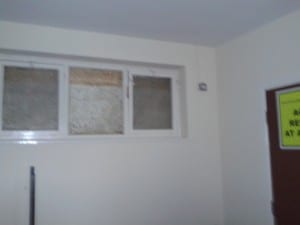In my previous blog (The Wall), I touched upon the notion of rituals. The whole group has seemingly integrated the idea of rituals more and more frequently as the performance rehearsals have progressed. For example, the T.A.N.K group have recently explored the technique of repeating a series of moves with chairs, to create the simulation of a moving tank. The regimented physicality of the piece also suggests the serious backdrop of warfare.
The art of performance itself is speculated in site-specific performance, as performers are exposed to “extended conditions of surface, climate and architectural enclosure” ((Pearson, Mike (2010) Site-Specific Performance, Basingstoke: Palgrave Macmillan.)) that we are not usually subjected to in a theatre. Furthermore, our bodies and voices are affected by sites not designed for theatrical performances, and the performers must adapt. For example, our Women of War piece is largely set in the kitchen/shower/wash room, located at the far end of the Weighing Room. Becoming factory women of the war, we perform patterns of movement and actions that resemble their roles. Phoebe and Emily’s characters’ perform a sewing routine, folding and cutting material, whilst my character weaves through the space pouring tea and sweeping the floor. The ritualistic movement demonstrates how we are at one with the site, and are responding to the objects around us. Moreover, “Tschumi speaks of ‘architecture in an expanded sense whereby the movement of bodies in space [is] just as important as the space itself’” ((Turner, Cathy (2010) “Mis-Guidance and Spatial Planning: Dramaturgies of Public Space”, Contemporary Theatre Review, XX (2): pp. 149-161.)). Gododdin (1988), performed by Brith Gof, also suggests that site-specific performance is strongly associated with physical theatre, as the “performers are put to the test” (Pearson 2010, p. 173). Totem (1998), by Lone Twin, also demonstrates how “the physically gruelling effort expanded by the performers drew attention to the actual process of labour inherent in the piece” ((Govan, Emma, Helen Nicholson and Katie Normington (2007) Making a Performance: Devising Histories and Contemporary Practices, London and New York: Routledge.)). Thus, the audience are watching something real occur, and the repetitive, formulaic movements that we have created, help to exaggerate this concept.
Another form of ritual that occurs is the journey that binds the Grandstand performance together. As part of the Women of War group, it is planned that our characters will become guides for the audience. Our leadership though the performance demonstrates our on-going exploration of the site, and is a method of chorography. Ingold states that “To be a place, every somewhere must lie on one or several paths of movement to and from places elsewhere. Life is lived, I reasoned, along paths, not just in places, and paths are lines of a sort” ((Ingold, T. (2007) Lines: A Brief History, London and New York: Routledge.)). In effect, we are mapping out the site with our movement, which is similarly presented towards the end of the performance. A key idea of the Restoration group is to plot the outline of the original Grandstand that once stood on the site, with yarn, so that the audience have a vivid image of the site’s past. The audience will be led around the shape, in silence, for each of them to read the ideas about the site’s future that have been attached to the yarn. This journey is itself a moment of ritual, as the audience can reflect on what they have seen and imagine what they would like the site to be.
Ultimately, the use of ritual, through journeys, physical theatre and repetitive sequences, will emphasise our connection to the site and encourage the audience to respond themselves.
